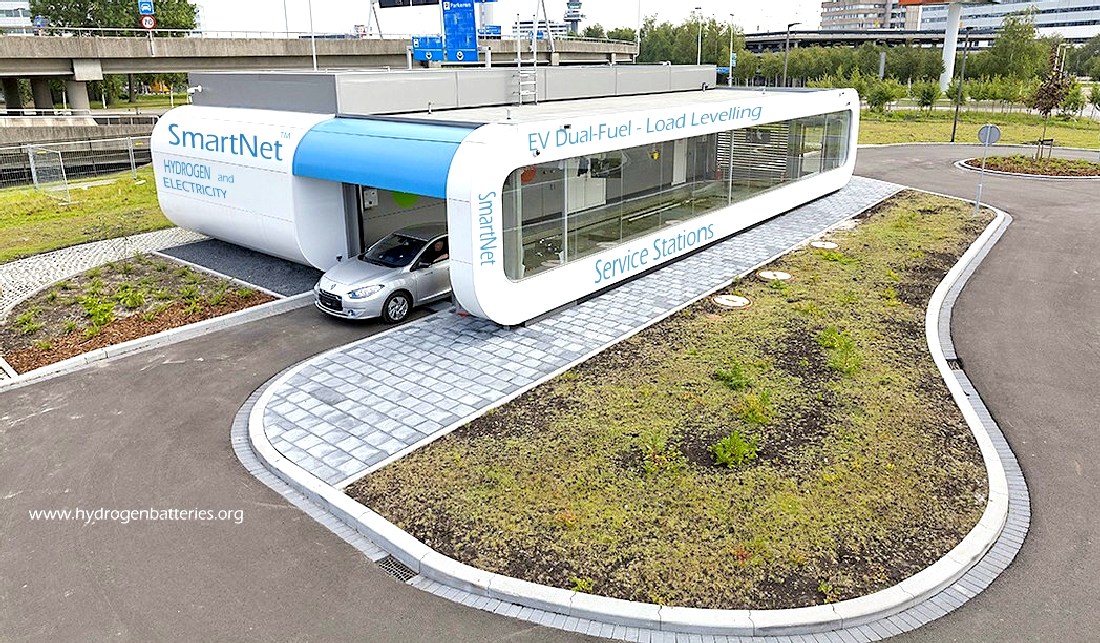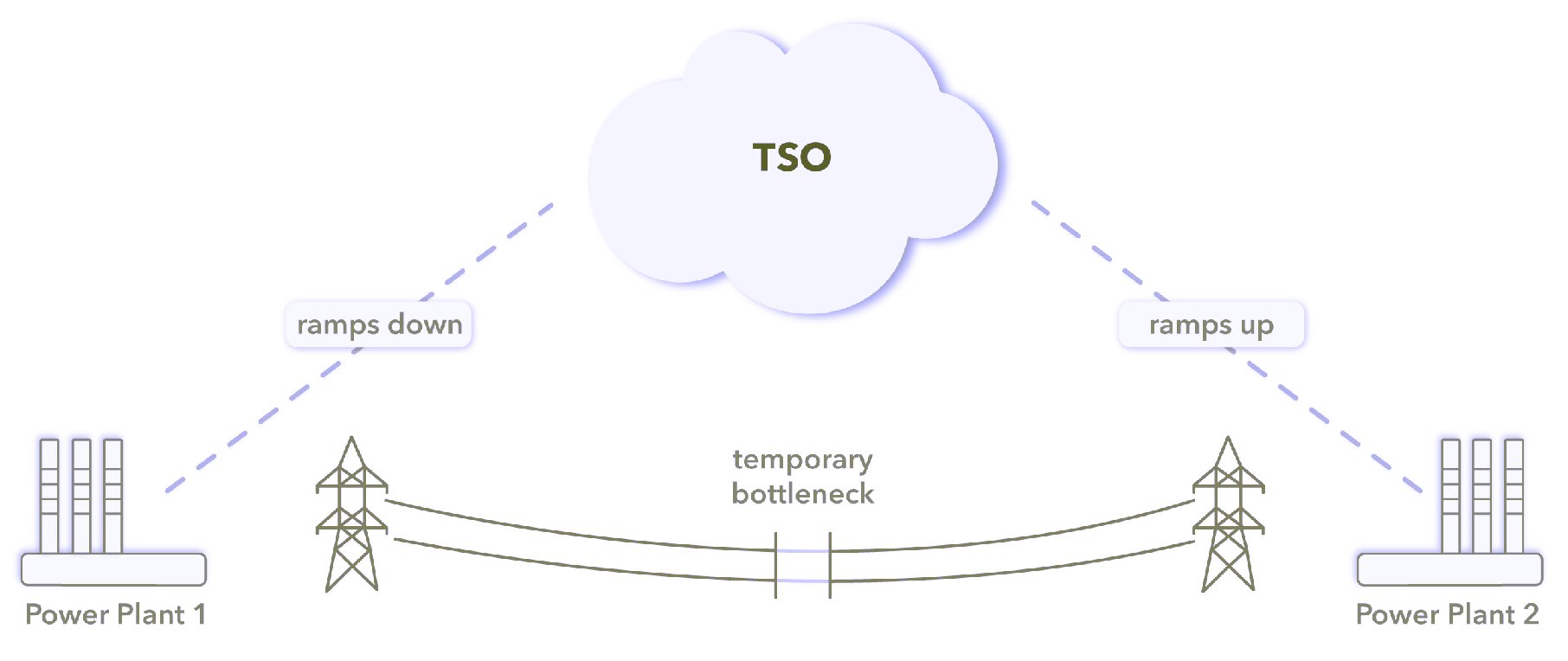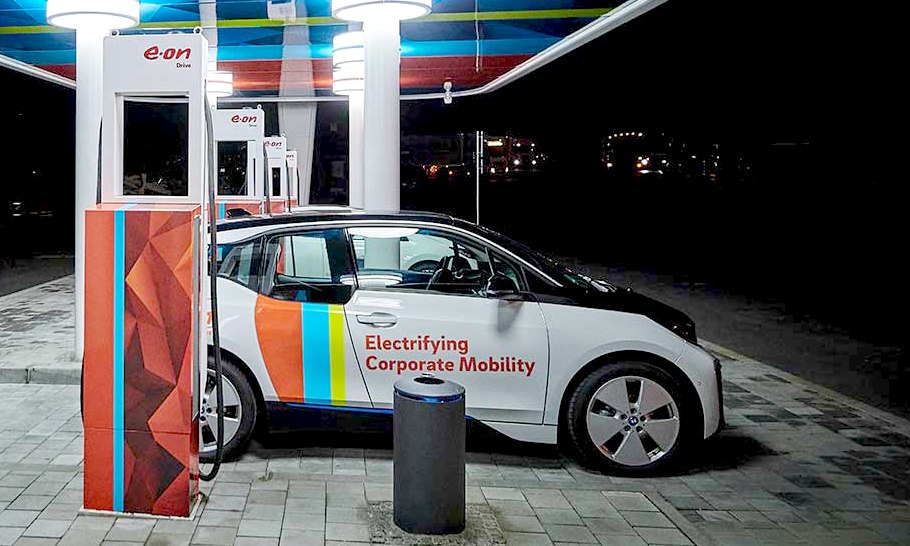|
DISPATCH & REDISPATCH
Please use our A-Z INDEX to navigate this site where page links may lead to other sites, or see HOME
|
|
|
For a power network to remain stable, the amount of electricity fed into the grid must equal that being drawn out of it, at any point in time. Imagine then, a means to store electricity as green hydrogen for the load levelling of national grids, while also supplying energy for commercial vans and heavy duty trucks. Fuel cells provide a way to convert hydrogen gas into electricity, but on their own they do not represent a solution. The way forward is with hydrogen batteries, as the beating heart of the Smartnet™ dual-fuel infrastructure.
Smartnet™ service stations could be developed to automatically detect voltage and frequency deviation, and soak up or supply energy to networks to keep them running efficiently.
Electricity doesn't have a fixed price. It is (short-term) traded, like a commodity. You need to buy and sell at the right price. Hence, efficient operation of power plants becomes important, to stay in business, and this is where resource planning is important.
The term ‘dispatch’ refers to resource planning at an electricity generating power plant, by the plant’s operator. The term ’Redispatch’ refers to a short-term change in how a power plant is utilized. Requests come at the behest of a Transmission System Operator (TSO) to prevent bottlenecks in the grid.
DISPATCH
Dispatch exists to achieve the most economically profitable operation schedule at a power plant - whose sole objective is to make money from generating electricity - from converting a fuel source (coal, oil, gas) into electricity, this includes hydro and renewable electricity.
This calculation includes the variable costs of each plant (such as the cost of fuel at a coal-fired plant) along with anticipated prices on the energy markets. A power plant will only operate if its variable costs come in lower than the sales prices that can be secured - or it loses money.
Dispatch creates a schedule that determines the allocation of available capacity for the plant or plants. Factors include:
1. Location (which plant will be used?) 2. Time (how long will the plant be used, and from when?), and 3. Graduation (should the plant run at a partial or full load?)
Power plant operators are usually required to register their schedule with the respective transmission grid operator to enable forecasting of the grid’s available power.
Dispatch is also used in the field of renewable energies. Operators of fluctuating renewable energies, such as solar power and wind power, evaluate weather forecasts and plant availability to determine the following day’s schedule.
Controllable renewable energy operators create multiple-day schedules for their assets, which might include biomass and hydropower plants. This allows an operator to base resource allocation on prices from the energy exchange.
REDISPATCH
Redispatch is mainly used in regions with a high proportion of renewable power production, such as California or Germany. It is less common in other regions, but will of course extend to all regions as we wean off coal and nuclear power. At that stage smart load-levelling becomes much more important, with automation seen as being essential with vehicles using electricity. At this stage Smartnet™ service station come into their own.
To further understand redispatch, consider how power plants submit their schedules to transmission system operators as outlined above. As soon as the schedules have been received, the grid operators conduct what is known as a load-flow or grid-load calculation to prepare an overview of the grid’s expected feed-in and consumption for the next day.
They analyze the dispatch to determine if any parts of the electricity grid might be negatively impacted, and to what degree.
To keep the number of the next day’s short-term, grid-stabilizing interventions at a minimum, the transmission system operator can instruct plant operators to postpone schedule power production based on the next day’s load-flow calculation to prevent grid bottlenecks.
The request to shift electricity production is called a redispatch.
GERMANY AS A REDISPATCH EXAMPLE
Germany’s power system is increasingly based on fluctuating renewable energy sources, and that’s creating challenges for the country’s grid operators. In days gone by, conventional power was supplied to meet demand by a few large power stations.
Now,
with renewables, a change of weather can result in a sudden influx of electricity.
Meaning that TSO
and DSO operators have to work hard to keep the grid stable, through “re-dispatch” measures that ensure a balance between supply and demand.
In February 2016, wind farms generated an unprecedented 33 gigawatts (GW) of electricity on a single day. All that additional power has to go somewhere – and often its needed most in Germany's industrial south.
On particularly windy days when demand in the north is low, this means renewable electricity fed into the grid exceeds the capacity of the power lines that are supposed to transport electricity to the south of the country. A kind of congestion (or block) occurs, forcing grid operators to take re-dispatch measures in order to stabilise the network.
B. They can temporarily shut down wind turbines (only as a last resort, because renewables have grid priority)
C. They can order conventional power stations in south Germany to produce more electricity to meet demand from consumers in the south whose suppliers bought north German wind power that can’t get through.
All of these re-dispatch measures result in extra costs for consumers:
E. When grid operators order renewable power producers to disconnect from the network, they too must be compensated for some of their lost profit
F. Conventional power stations in south Germany that grid operators call on to produce extra power, do so at costs higher than the market price.
In 2014, re-dispatch interventions were necessary on 330 days (232 in 2013), concerning 5,197 gigawatt-hours (GWh) of power, and costing
€186.7 million euros (132.6 million in 2013), the Federal Network Agency
reported @ p.100 monitoring report 2015.
Compensation payments for the curtailed renewables increased by more than seven times from €43 million euros in 2013 to nearly €315 million euros in 2015. Clearly, TSOs could benefit from Smartnet™ installations at strategic locations, where the €millions of euros wasted in compensation payments could have gone to developing an asset to reduce forward operational costs.
One company that specializes in electricity use prediction and trading is:
Next Kraftwerke GmbH
Energy transition means decentralization. The age of a few huge power plants providing for all of the energy supply in grid is passé. Distributed energy resources are already and will continue to be the trade mark for an energy system based on renewable energy resources.
LINKS & REFERENCE
https://www.comparethemarket.com/energy/electricity/ https://www.cleanenergywire.org/factsheets/re-dispatch-costs-german-power-grid https://www.next-kraftwerke.com/knowledge/dispatch
Please use our A-Z INDEX to navigate this site
This website is provided on a free basis as a public information service. copyright © Climate Change Trust 2021. Solar Studios, BN271RF, United Kingdom.
|


